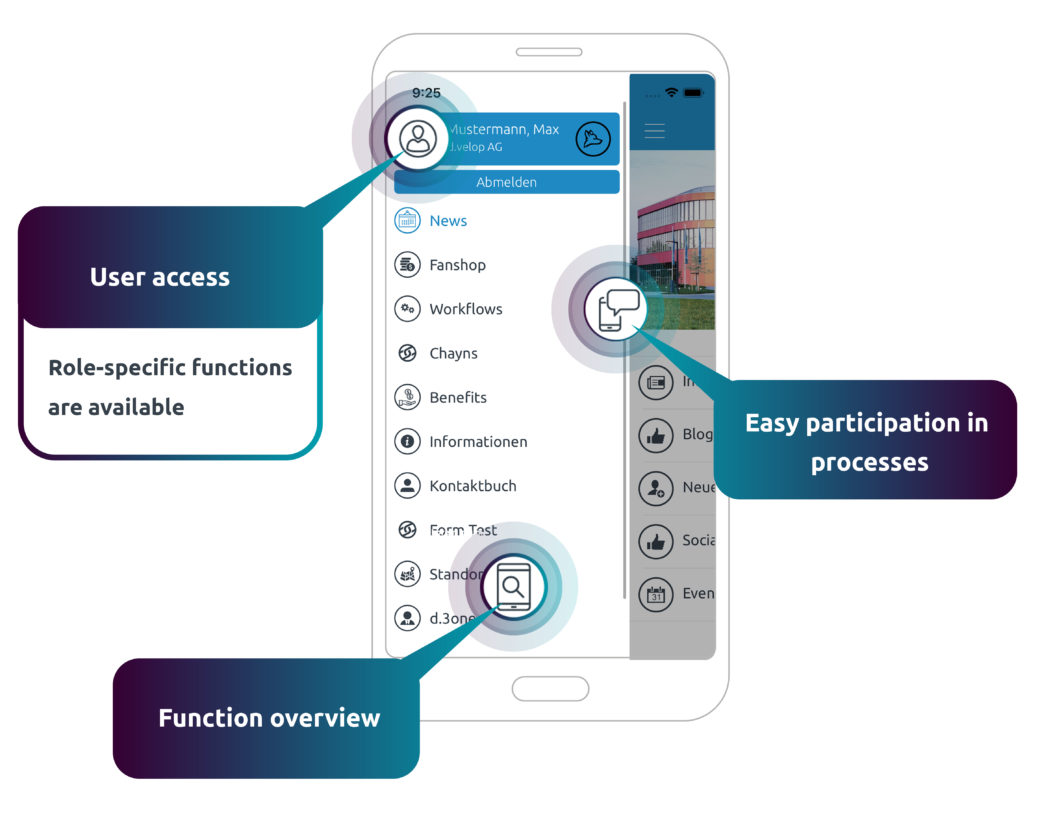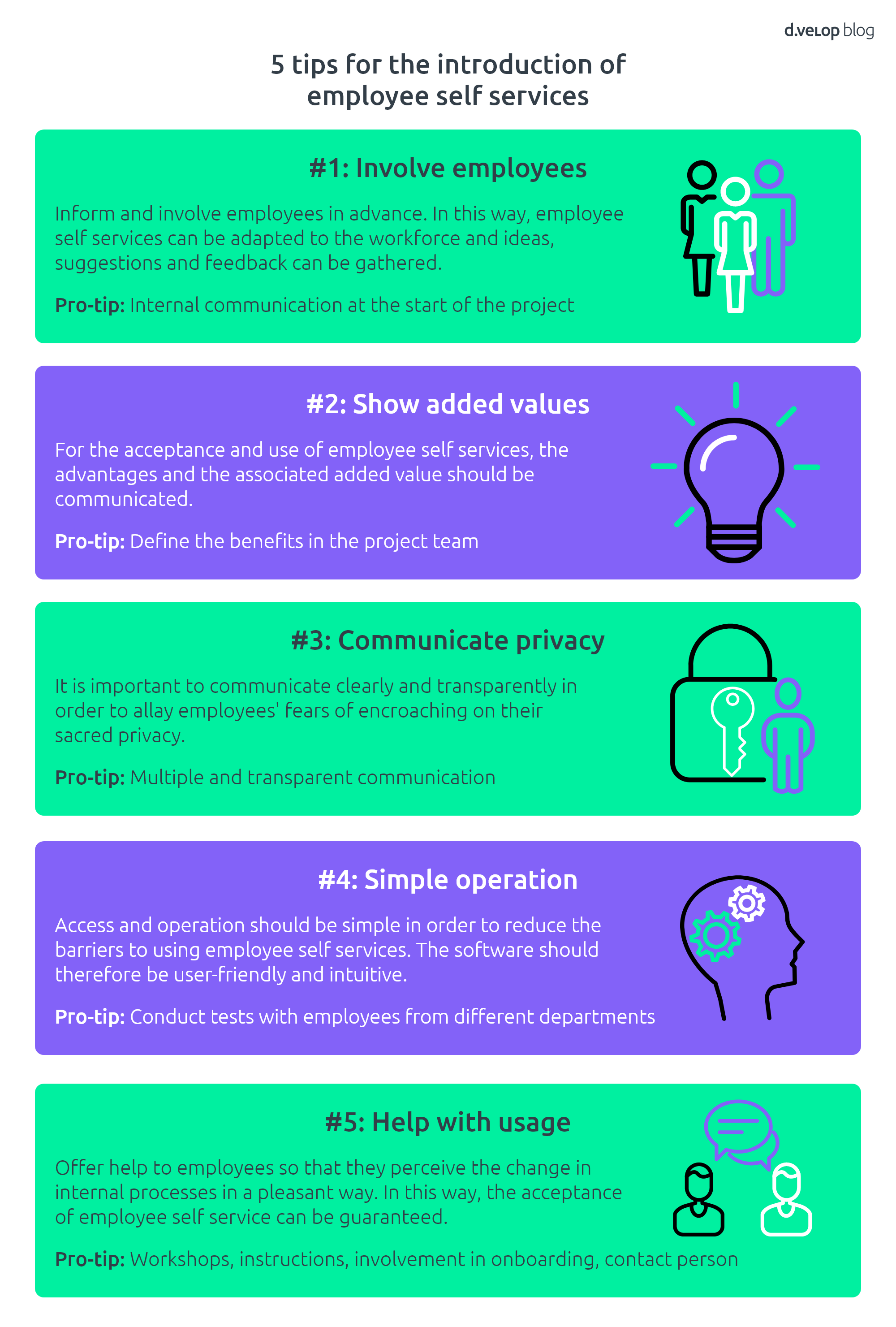Fishing out information from a multitude of emails, including address changes, holiday requests, sick notes – probably a classic in HR departments without digital self-management solutions. It could be so simple! In this blog article, we explain exactly how employees can take these and other processes into their own hands by using Employee Self Service, without having to wait long for answers.
Definition Employee Self Service
The term Employee Self Service (ESS) means “employee self-service” or “employee self-administration”. This means the use of software or web-based application programs to carry out personnel-related procedures and processes under the employees’ own direction.
Why the introduction of Employee Self Service makes sense
Human resources managers fight for good employees every day. The aim is to retain and retain current employees as well as to recruit new, talented people for the company. The shortage of skilled workers and the labour market make this task enormously difficult. What’s more, there is also a lack of employees in the HR department. As a result, the workload of HR staff is increasing and many tasks have to be completed in less and less time. It is therefore all the more important to start here and to counteract the lack of time and the resulting higher susceptibility to errors through employee self-service options. In this way, overworked HR staff can be relieved of administrative tasks in particular and employees can be enabled to carry out processes more quickly.
How do HR professionals benefit from Employee Self Service?
As already described, the introduction of Employee Self Service facilitates the daily work of HR staff. The five main advantages are as follows:
- Process acceleration: Work and communication channels are significantly shortened, as all those involved have direct access and can make queries/changes in a short time. The elimination of media discontinuities thus leads to a faster process flow.
- Relief and more time for strategic tasks: The elimination of some process steps relieves the HR department of monotonous tasks and thus allows time for important strategic issues.
- Reduction of the error rate: The reduction of process steps lowers the error rate during processing.
- Improvement of data quality and transparency: Since employees have access to the master data at any time, entries, changes and updates of, for example, address, telephone number, but also attendance/absence records can be made. This leads to up-to-date data records and greater transparency in the company.
- Reduction of printing costs and paper consumption: Selected processes only take place digitally and no longer on paper, which reduces printing costs and largely eliminates paper consumption.
A Successful Rollout of Digital Personnel Files in Three Phases 🚀
What added value does the introduction of Employee Self Service offer to the employee?
In addition to the benefits for the HR department, it is above all the employee who benefits from self-service. This is because the active integration into HR processes creates many advantages. For example, the increased autonomy, as the employee has the possibility to use the functions of Employee Self Service due to the time and location-independent access. This simplifies everyday life for employees who work remotely or do not have a fixed workplace (so-called non-desk workers). This is because the processes can be initiated independently of the HR department, in the best case comfortably via the private mobile phone. Employees are thus more flexible and can act at short notice. The shorter communication channels enable smooth processes. This in turn leads to processes being completed more quickly, as the processing time is shortened, which leads to increased employee satisfaction.
Examples of Employee Self Service
Employee Self Service functions can be used in a variety of ways. Because updating personnel data is by no means everything. The following functions, among others, are part of Employee Self Service and can be used directly by employees:
Personal functions:
- Applications (e.g. holiday application, parental leave application)
- Absence recording (e.g. sickness notifications)
- Viewing payroll accounting
- Claims notification
- Master data changes (e.g. address, telephone number)
- Time recording
- Information (e.g. leave balances, time statement, remuneration slips)
- Approvals (e.g. business trips)
Company-wide functions:
- Surveys
- Feedback
- Appraisals
- Phone book
Location-related functions:
- Booking pool vehicles
- Room reservations
- Car wash/truck wash
Which software is used for Employee Self Services depends on various factors. Should all functions really be possible? Are certain functions even needed by the workforce? What really makes sense for employees and the company? Only when these questions have been answered can the search for suitable software begin. A distinction must be made between HR software that enables all possible features of Employee Self Services (special ESS software) and HR software that specialises in certain processes.
The d.velop employee app is a solution that can be used to automatically trigger HR processes such as holiday applications and sickness notifications via app. The mobile solution enables easy and quick access to essential workflows at any time and from anywhere. Through the integration of digital salary delivery via the d.velop postbox, the delivery and retrieval of the salary statement is possible at any time. Receipts and other documents can also be stored here.
Tips for the introduction of ESS
You should pay attention to this!
In addition to the advantages, there are also some challenges that have to be overcome with Employee Self Service. For example, data security is an essential aspect that is particularly important when introducing an employee self-service. Furthermore: Good project management and a successful introduction of an ESS also include an extensive cost calculation. In addition to the acquisition costs, training measures, security checks, etc. are also necessary.
Demo for the d.velop employee app 💻
Book your individual software demo for the d.velop employee app with just a few clicks. Let our experts show you the software live and ask your questions directly.
Conclusion
In summary, the introduction of Employee Self Services has enormous benefits for both the HR department and the employees. It makes everyday work easier in many ways and leads to fluid internal processes. Which processes are to be digitalised and which software is to be used for this varies from company to company. One thing is clear: those who have taken the step will certainly not want to go back.


